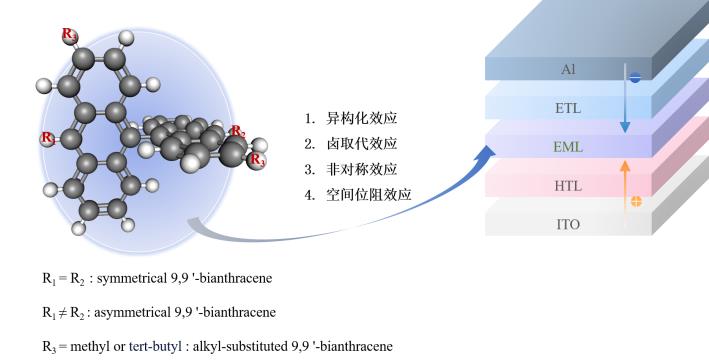Abbreviation (ISO4): Prog Chem
Editor in chief: Jincai ZHAO


9,9'-Bianthracene-Based Blue Fluorescent Emitters for High-Performance Organic Light-Emitting Diodes
Aowei Zhu, Zhanfeng Li, Kunping Guo, Yanqin Miao, Baoyou Liu, Gang Yue
Prog Chem ›› 2025, Vol. 37 ›› Issue (3) : 317-331.
9,9'-Bianthracene-Based Blue Fluorescent Emitters for High-Performance Organic Light-Emitting Diodes
Organic light emitting diodes (OLEDs) have attracted extensive attention and research interest in advanced display and solid-state lighting due to their self-luminescence, low drive voltage, wide color gamut, surface luminescence, flexibility and rapid response. One of the primary colors of OLED, the development of blue emitter is still lagging far behind. Interestingly, 9,9'-bianthracene as a promising blue-emitter for high-performance fluorescent OLEDs exhibits excellent optoelectronic performance in recent years. Here, we review the progress with the development of 9,9'-anthracene-based blue fluorescent materials and gain insight into their contribution towards enhanced OLED performance. Different approaches to achieve blue emission from molecular design including isomerization, fluorine substitution, asymmetrical structuring, and steric hindrance effects are discussed, with particular focus on device efficiency and stability. Furthermore, an outlook for future challenges and opportunities of OLEDs from the development of new molecular structures, understanding of luminescence mechanisms as well as innovation in flexible and large-scale panels is provided.
1 Introduction
1.1 OLED structure and principle
1.2 OLED emissive materials
2 9,9'-Bianthracene-based blue light-emitting materials and device performance
2. 1 Basic structure of bianthracene
2. 2 9,9'-Bianthracene-based blue light-emitting materials and devices
2. 3 Structures and chemical properties of other bianthracene derivatives
2. 4 BT. 2020 blue light
Correlation between the structure and performance of 9,9'-Bianthracene-based blue light-emitting materials
3. 1 Isomerization effects in bianthracene
3. 2 Halogen substitution effects
3. 3 Asymmetric effects
3. 4 Steric hindrance effects
3. 5 Blue-emitting device design
4 Conclusion and prospects
4. 1 Summary
4. 2 Prospects

9,9'-bianthracene / fluorine substitution / isomerization / steric hindrance / blue fluorescent emitter materials / organic light-emitting diodes
| [1] |
|
| [2] |
|
| [3] |
|
| [4] |
|
| [5] |
(董馨雨, 丁文超, 陈美玲. 中国照明电器, 2023(10): 40.).
|
| [6] |
(焦志强, 黄清雨, 张娟, 李晓虎, 袁广才. 新材料产业, 2018, (2): 25.).
|
| [7] |
(项兴焜. 电子测试, 2022(24): 139.).
|
| [8] |
(徐汀. 材料研究与应用, 2022, 16(5): 730.).
|
| [9] |
|
| [10] |
(邹建华, 朱冠成, 王磊, 徐苗, 吴为敬, 彭俊彪. 发光学报, 2023, 44(1): 198.).
|
| [11] |
(马永强. 机械管理开发, 2020, 35(11): 295.).
|
| [12] |
(孙阿辉, 李耀召, 陈果, 魏斌. 光学学报, 2022, 42(4): 171.).
|
| [13] |
|
| [14] |
|
| [15] |
|
| [16] |
|
| [17] |
(崔东岳, 王帅, 李淑红, 刘云龙, 王文军. 发光学报, 2021, 42(5): 691.).
|
| [18] |
|
| [19] |
(唐振宇, 郭浩清, 肖静, 陈志坚, 肖立新. 发光学报, 2023, 44(1): 26.).
|
| [20] |
|
| [21] |
|
| [22] |
|
| [23] |
|
| [24] |
|
| [25] |
|
| [26] |
(田禾, 苏建华. 世界科学, 1996, (11): 24.).
|
| [27] |
|
| [28] |
|
| [29] |
|
| [30] |
|
| [31] |
|
| [32] |
|
| [33] |
|
| [34] |
|
| [35] |
|
| [36] |
|
| [37] |
(娄敬丽, 黎刚刚, 王志明, 唐本忠. 发光学报, 2023, 44(1): 37.).
|
| [38] |
|
| [39] |
(张秀菊, 许运华, 史华红. 化学进展, 2006, 18(7/8): 870.).
|
| [40] |
(张慧东, 谷盼盼, 张芳, 都明旭, 叶开其, 刘宇. 高等学校化学学报, 2021, 42(12): 3571.).
|
| [41] |
|
| [42] |
|
| [43] |
|
| [44] |
|
| [45] |
|
| [46] |
|
| [47] |
(薛云娜, 柴生勇, 别国军, 刘波, 甘宁. 现代显示, 2008, (04): 29.).
|
| [48] |
|
| [49] |
|
| [50] |
|
| [51] |
|
| [52] |
|
| [53] |
|
| [54] |
|
| [55] |
|
| [56] |
|
| [57] |
|
| [58] |
|
| [59] |
|
| [60] |
|
| [61] |
|
| [62] |
|
| [63] |
|
| [64] |
|
| [65] |
|
| [66] |
|
| [67] |
(吕响. 太原理工大学硕士论文, 2017.).
|
| [68] |
|
| [69] |
|
| [70] |
|
| [71] |
|
| [72] |
|
| [73] |
|
| [74] |
|
| [75] |
|
| [76] |
|
| [77] |
|
| [78] |
|
| [79] |
|
| [80] |
|
| [81] |
|
| [82] |
|
| [83] |
|
| [84] |
|
| [85] |
|
| [86] |
|
| [87] |
|
| [88] |
|
| [89] |
|
/
| 〈 |
|
〉 |